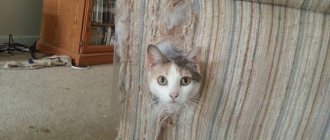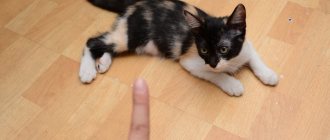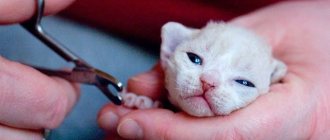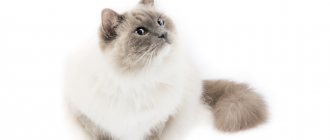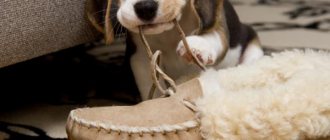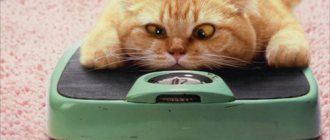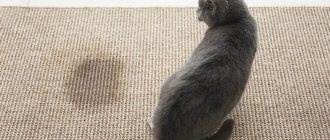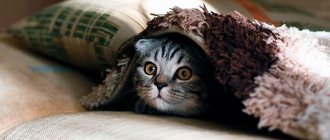Nature gave cats claws for a reason. They play an important role in the life of an animal: they help to grab the desired object and hold it for as long as possible. Pets need to wear down their overgrown claws, and they often choose unsuitable objects for this: sofas and chairs, corners, rugs. How to stop a cat from tearing furniture and wallpaper, while remaining on friendly terms with it?
Why do cats scratch textiles and wallpaper?
Nature gave cats claws for a reason. They play an important role in the life of an animal: they help to grab the desired object and hold it for as long as possible. Another option is for the animal to be held using its claws on various inconvenient surfaces.
Claws perform another important function: the animal uses them to mark territory. The thing is that the spaces between the paw pads have glands. And the glands produce pheromones, which send signals to other cats in the area - there is already an owner here.
Another reason for sharpening claws is to relieve stress. For example, when very frightened, upset or overexcited, a cat scratches an uneven surface, thereby “letting off steam.”
Finally, overgrown claws simply get in the way of the cat. If she is not accustomed to a special scratching post, furniture or joints in the house will definitely suffer from her paws.
All these “good reasons” are listed to make it easier to understand how to stop a cat from tearing up furniture. It is not so easy to discount hundreds of thousands of years of evolution and innate instincts.
What kind of coverings is a cat indifferent to?
The cat chooses hard surfaces of furniture items for sharpening its claws for a reason. In the natural environment, they often scratch the bark of trees, but at home they find a completely alternative solution in the form of interior furniture.
In addition to wooden facades, they are attracted by the soft upholstery of sofas and armchairs. Thick curtains, walls with wallpaper and carpets are also quite suitable for sharpening claws.
If you have started renovations in a house where a cat lives, you can pre-select materials for interior decoration that are unsuitable for sharpening claws.
Which surfaces are not interesting for furry friends:
- fiberglass wallpaper;
- ceramic wall tiles;
- fake diamond;
- decorative plaster;
- plastic panels;
- high strength laminate;
- smooth linoleum;
- PVC floor tiles.
Unfortunately, manufacturers have not yet come up with furniture that would not provoke the desire to scratch their claws. To protect the upholstery of your favorite sofa and armchairs, experts recommend purchasing thick covers in advance to cover soft surfaces.
How to wean an animal
Of course, the first thing you need to do is buy a scratching post. But in parallel with the process of accustoming to it, you need to ensure that the kitty stops misbehaving in other places. There are several good ways to do this.
Reflex to sound
“No”, “You can’t”, “Who did this?” etc. Cats have an excellent memory for intonation. You can pronounce different words, but in an equally menacing tone, and the animal will immediately understand that the all-seeing and all-knowing owner is nearby, and he is dissatisfied.
You should not swear at the cat after he has sharpened his claws. Do this before or during grinding so that the animal understands why exactly it is being scolded.
Another weaning method is baby rattles. As soon as you notice that the cat is tearing the wallpaper, take a rattle and ring it loudly - the animal will get scared and run away. If you do this every time, he will have a reflex to this sound. This method is bad for small kittens and overly sensitive cats - they may develop a stressful condition.
Spraying with water
If a cat ignores sounds and still picks at the wallpaper, how can we wean her from this bad habit? Many owners resort to using a spray bottle.
Everyone knows that cats don't like water. Therefore, a spray bottle with plain water can become your faithful assistant. Every time the animal decides to do a manicure on a chair, sofa or corner, simply spray it with water. This method helps even the most obstinate pets.
This procedure is effective before or 5 seconds after the “crime”, otherwise the animal will not understand why you are doing this to it. Unpleasant sensations should be associated with the offense.
Unpleasant aroma for cats
Cats have an excellent sense of smell, and this quality can be beneficial to the owner. Where the cat has chosen a place to sharpen its claws, you can hang fragrant sachets with lavender, citrus, and rosemary. Another option is to periodically drip essential oils of patchouli, ylang-ylang, lavender, eucalyptus, and pine onto the problem area.
Sticky surface
The fluffy impatiens will not tolerate it if its favorite joint has turned into a sticky surface. This is easy to do: carefully stick tape or self-adhesive paper inside out to the wallpaper.
If furniture suffers, on which it is impossible to spread adhesive tape, you can protect the approaches to it in the same way: spread a real sticky field on the floor. The most important thing is that before the cat gets out of the habit of sharpening its claws in the wrong place, it does not fall into the sticky trap itself.
Vibromat
Since it is not always easy to stop a cat from scratching the sofa, sometimes you have to fork out for non-standard solutions.
One of the effective ways to keep your pet away from furniture and other places in the house is a vibrating mat. The device runs on batteries. The duration of the vibration wave is 3 seconds.
Place a mat where you don't want your pet to walk. When you step on the mat, a vibration signal is sent, forcing the animal to leave this place. Some models are equipped with an additional feature - a sound signal. You can purchase this device at any online or pet store. The price fluctuates around 2-3 thousand rubles.
Voice commands and loud sound
How to stop a cat from scratching upholstered furniture? Scare her with loud noises! The reaction will be immediate!
For this purpose, you can use various available items:
- baby rattle;
- balloon;
- a soda can with coins inside;
- loud clapping of hands.
When raising a pet, you should not ignore raised voice commands. Cats are smart by nature and understand their owner's intonation well. If she hears dissatisfied words about her bad behavior in a message, she will definitely draw the appropriate conclusion.
True, such conclusions are more relevant for adult representatives of the feline species.
Small kittens are more playful and disobedient, but if you teach your baby the “no” command from an early age, you can raise a well-mannered cat with good manners.
If education doesn't help
Sometimes scratching posts do not completely eliminate the problem, so you need to look for alternative methods of dealing with a rowdy pet.
Trimming and filing nails
How to stop a naughty cat from tearing wallpaper and furniture if all previous methods do not help? Perhaps the first thing that comes to mind is to trim the claws and thereby minimize the damage.
To trim claws, purchase a special device - a nail cutter, literally cutting off 1-1.5 mm of the regrown length. The device is quite convenient and allows you not to stretch out the procedure, therefore, the cat does not have time to get nervous.
You need to trim the claws very carefully, otherwise you can remove excess nails and harm your pet. Do not touch the blood vessels - they are located in the pinkish corners that are visible through the light.
Another, more expensive option is to take your pet to the vet. It doesn’t matter whether you have a small kitten or an adult cat: with a specialist, the animal will take the claw trimming procedure more calmly. Moreover, the veterinarian’s actions last no longer than five minutes.
Overhead anti-scratch pads
Anti-scratch caps look like silicone caps: they are attached directly to the animal’s claw using special glue. The glue is made of hypoallergenic substances and does not harm the cat.
Veterinarians warn: not all pets allow themselves to be put on “shoes” for their claws. Sometimes an animal tries to get rid of an incomprehensible attribute on its paws - this is a natural process of self-defense. Over time, the pet gets used to them and does not pay attention. In rare cases, the most active furries chew off the silicone caps, and after 3 hours all the claws are open again. But it’s still worth trying this method, since not all pets react negatively to anti-scratch treatments.
To correctly select the size of the caps, the owner must know the exact weight of the pet. Any pet store will help you choose the necessary anti-scratch pads for your pet using a size chart. You can also order them online: they are inexpensive and look nice.
Insulation of expensive furniture
Listed above are the most common and effective ways to wean your domestic cat from scratching furniture and wallpaper in the house. But it happens that none of the expert advice helped solve the obvious problem.
If your pet turns out to be more cunning and intelligent, try trying other methods of combating the bad habit. One of them is to isolate the attractive surface of upholstered furniture with durable covers made from fabrics that are not suitable for sharpening claws. Even if the cat ruins the bedspread, you can always buy a new one - it’s easier than changing furniture.
Another way is to keep the cat out of the room where it is sharpening an illegal object. Close the door tightly and under no circumstances allow your pet to come inside, even with you. The temptation will disappear and the habit of turning to the scratching post will appear.
Special sprays
Sometimes stopping a cat from tearing up wallpaper and furniture is like winning a war. You need to try all the means for one of them to work. Cats have a sensitive sense of smell, so you can turn to special products from a veterinary pharmacy. If you spray furniture with this spray, the cat will not come close to it.
You can buy a miracle spray at a pet store or prepare it yourself. You can make this remedy from an infusion of spices, a mixture of water with essential oils of citrus fruits, pine needles, rosemary, sage, eucalyptus or lavender.
In practice, many cats continue to tear wallpaper and furniture, even if a whole bottle of special liquid is poured on it. But it’s still worth trying this method - it suits some fluffies.
If the cat continues to tear up the furniture
How to proceed in this case? There are several most effective methods, but they can be inconvenient for both animals and humans.
The simplest one is to cover all the places that the animal is trying to damage. In addition, stores now sell very comfortable anti-scratch pads. This method is considered quite controversial and its safety has not yet been proven.
And the most inhumane and cruel way is declawing. It can end badly for your pet, so you should definitely talk to your doctor before deciding to do this.
What not to do
One cannot be inconsistent in weaning an animal from a bad habit. This means that it is useless to scold the cat once for a mistake, and a second time to ignore it. Every crime noticed must be punished.
You cannot hit a cat; you can scare it with a slap of a towel or rolled up paper. The animal will not experience pain, but will feel the effect of surprise - as in the case of a loud shout or the ringing of a rattle.
An animal cannot be punished by being locked in a room, left without food or drink - it will definitely not understand why such harsh methods were applied to it, and will only suffer. Particularly sensitive people may become ill due to a bad attitude.
And of course, in no case should you wean your cat from damaging furniture or wallpaper if there is no place in the house specially equipped for these matters. A cat will not be able to avoid sharpening its claws at all: this is the same need as eating, drinking, sleeping and relieving itself. Therefore, scolding a cat before purchasing or creating a scratching post is pointless.
Why does an animal ruin furniture?
There are several reasons why a cat scratches furniture and wallpaper. For example, this is how she performs “physical gymnastics.” By extending and retracting its claws, the pet stimulates the work of the ligaments. It also strains and stretches muscles, kneads joints.
The natural need of the feline species is to grind off the upper stratum corneum from the claws, since it will interfere with the animal’s movement and can dig into the pads on the paws.
In nature, pets do this with the help of trees, so they may mistake home furniture or wallpaper for a natural scratching post.
There are psychological reasons why a cat tears up furniture:
- Jealousy of other pets or defense of one's territory. On the surface of cats' paws there are special glands that secrete pheromones. The human sense of smell is not able to distinguish this smell, but for animals it means that the territory belongs to the creature that marked it. They can interrupt the marks of other pets with their own.
- A stressful situation in which a cat finds itself can become a reason for property damage. For example, if the animal’s owner has changed or the owner pays too little attention to the pet. Also, cats are always stressed due to moving to another place of residence or getting a new pet.
The death of the owner and his long absence from home can negatively affect the animal’s psyche, which also often serves as a reason for scratching interior items.
The reason why an animal scratches furniture is often due to age. Little kittens have not yet been trained in anything, and may simply not know that they should not tear up the sofa or wallpaper. Also, young animals are often very active and playful. They do it out of boredom, to get attention or just to get some exercise.
If you don’t teach a young pet the right place to sharpen its claws, it can get used to damaging upholstered furniture, but it’s much more difficult to wean an adult animal off.
Selection and training to a scratching post
The easiest option is to purchase a scratching post, maybe even several, so that the cat has a choice. Scratching posts are made from sisal, hemp or burlap - natural materials are attractive to pets and do not cause allergic reactions. It is important that the scratching post is secured and does not wobble or fall.
In modern stores there is such a variety of devices that it makes your eyes wide open. How not to get confused and choose something that your pet will like and fit into the interior? There are several types of scratching posts:
- Wall mounted
. The stationary scratching post looks like a board and is mounted on the wall. It is covered with sisal rope or canvas. For animals that prefer to crawl into corners and walls, corner scratching posts were invented. They consist of two planks.
- Floor-standing
. They are divided into volumetric and flat. Flat ones resemble ordinary boards of various shapes. They are installed on a flat, smooth surface, and the pet claws against it, as if against a carpet or wall. Volumetric sharpeners look like posts attached to a wide base.
- Complex
. A whole set of multi-level sharpeners looks like a miniature sports field. Typically, such structures contain columns, shelves, and houses. In the complex, the cat can not only sharpen its claws, but also play and sleep.
You don’t have to buy a scratching post, but build it yourself: it doesn’t take much time or effort. For some animals, a log or a good piece of wood without splinters is enough. The main thing is to take into account the pet’s attraction to the type of surface (fabric, rope, wood) and the type of plane (horizontal or vertical).
Be prepared for the fact that the cat will not immediately recognize the scratching post: the acquaintance may take several days. Move the cat's paws along the rough surface, slightly pressing on the pads so that the claws come out. The animal will not immediately understand that the device is convenient for sharpening its claws.
As soon as the cat starts tearing up the furniture, pick him up and carry him to the scratching post. Let him complete the action himself: then the skill will be firmly established.
Training will take from 1 to 3 weeks on average. Make it a rule not to let your cat finish scratching the furniture by immediately taking him to the scratching post. Don’t forget about praise and other protective measures - trim the cat’s claws and spray restricted areas with repellent spray. A set of measures will speed up the education process.
Some tips for communicating with cats
All owners of furry pets should understand that a cat is a freedom-loving and independent animal. It is impossible to win her favor through threats and prohibitive methods. Only affection and proper upbringing can ensure friendly coexistence with your cat.
Allow your pet to explore the room and go where she wants from time to time. If your cat is already going outside, chances are they have the opportunity to sharpen their claws on a tree. Encourage this to keep your furniture safe.
Be patient and understanding of your pets' personalities. If you truly love your cat, she will definitely reciprocate your feelings and will always thank you with her purrs.
Don't forget that sharpening a cat's claws is a natural instinct and cannot be avoided. Over time, the cat will get used to the fact that you can sharpen its claws only in a specially designated place and will leave your furniture and wallpaper alone.
Buy a scratching post!
https://youtu.be/BpIgtwZSPZw
To maintain the integrity of the furniture in the house and prevent scratching the walls, purchase a special design for scratching claws - a scratching post. It is advisable to do this immediately after your pet arrives in the house in order to quickly accustom him to this product, which allows him to perform manicure procedures without damaging property.
Pet stores offer a huge selection of scratching posts of different models, for every taste and budget:
- simplified options in the form of a comfortable board upholstered in natural fabric;
- scratching posts in the form of a carpet and inclined models;
- floor and wall structures;
- model houses and various figures;
- multi-storey structures with a play area and a place to relax.
The selection is amazing! The main thing is not easy to choose a beautiful, but really comfortable and safe scratching post for your pet.
It is not difficult to accustom your cat to a new nail sharpening design. You can use pleasant smells to attract her, arrange fun games using this accessory, or lure the fluffy beauty with your favorite treat.
You can read more about this in our article on the topic “How to train a cat to use a scratching post.”
Common mistakes
Considering that animals have individual characters, there is no universal advice for owners. However, there are several methods that should not be used:
- cruelty - beatings will not force the cat to stop scratching furniture, but will make it distrustful and aggressive;
- loud screams - they frighten the animal, thereby interfering with the formation of a conditioned reflex;
- an attempt to wean the cat from scratching furniture without offering the cat an adequate replacement - a scratching post that is convenient for the animal;
- constantly moving the scratching post around the apartment. Once you have placed the item, try not to move it (alternative: purchase an additional scratching post);
- irregularity - when you start accustoming an animal to a scratching post, you need to adhere to a single strategy. If you forbid your pet from scratching the sofa, you will have to shoo him away and take him to the scratching post every time he starts his “manicure,” even if this happens at night. Otherwise, you will not get a positive effect.
Remember that you can punish an animal only if you catch it “at the crime scene”. Even if you spank him a minute after he stops scratching the upholstery, the cat will not understand why he is being spanked. This will not produce an effect, but it will make the furry purr distrustful.
